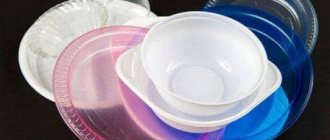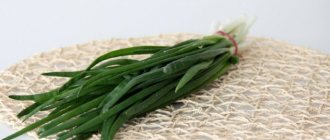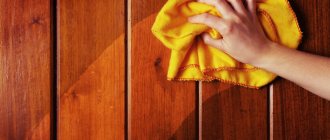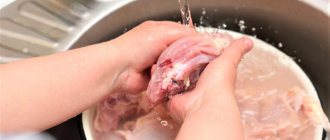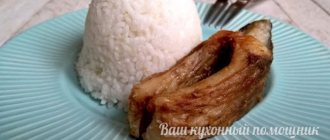The new kitchen, made of plastic facades, looks modern and beautiful. Today this interpretation is one of the most popular. The kitchen can be made in any color scheme and to suit different interiors.
The main task after purchase and installation is careful care and operation of the headset. This way it will last longer and will not lose its original appearance.
Since the kitchen is a fairly active area, quite a lot of pollution occurs there. When cooking and washing dishes, plastic facades quickly get dirty. This becomes very noticeable. The facade has a glossy finish, which reflects all fingerprints, drops and other traces. If you have time, it is better to walk over the façade with a slightly damp microfiber cloth after each cooking or after washing dishes. This way, all light dirt will be washed away and the kitchen set will be cleaned.
What not to clean the kitchen
Plastic, even the strongest and most durable, is a rather inert material, but at the same time porous. This combination limits the choice of care products; otherwise, you will have to update the set after several cleanings.
- It is strictly forbidden to wash facades finished with any type of plastic with abrasive agents. The substance scratches and damages even the most durable surface - for example, steel, let alone plastic. This cleaning method is especially bad for glossy kitchens.
Abrasives include both preparations containing solid particles and tools - metal brushes, sponges, etc.
- Do not use chlorine-containing substances. Even in cases where you need to clean old grease stains with your own hands. Chlorine destroys the coloring pigment, and the plastic loses its color and shine, and eventually deteriorates.
- It is undesirable to use alcohol-based medications. At the same time, glossy facades in the kitchen quickly fade, and matte ones take on the appearance of being dusted with dust.
- Do not use aggressive household chemicals intended for washing stoves, plumbing fixtures, ovens, and so on. The formulations often contain very potent ingredients.
- A general requirement when caring for kitchen furniture is keeping it dry. Constant contact with water is even more destructive than splashes of hot fat or dye. Therefore, the best way to care for a plastic kitchen with your own hands is to immediately wipe off dirt with a dry or slightly damp cloth made of flannel, plush or microfiber.
Washing kitchen furniture
To clean the kitchen you will need: gloves, sponges, soft cloths, a brush and household chemicals.
The kitchen will not look cozy if it is in disrepair. In order to wash the furniture in this room, preliminary preparation will be required.
You need to unload all the dishes from the kitchen furniture and wipe them inside. In places of heavy contamination, the racks are washed with soapy water using a sponge. It is necessary to work with gloves, since many effective products have an aggressive environment.
The shelves are washed separately using the same universal detergents. After this, you should take clean water into a large plastic basin, rinse all the furniture and rub it until it shines.
The next stage involves ventilation of furniture structures. If any odor persists after general washing inside the cabinets, wipe them with a cloth soaked in table vinegar. This almost always gives 100% effect. All! You can forget about the unpleasant smell for a long time.
The contents of the cabinets must also be washed, wiped and dried. Any home dishwasher is ideal for these purposes. Now you need to wash the cabinets from the outside. After this, small pieces of chalk or bags of rice should be placed in them. They have the property of absorbing water. This measure is necessary in order to completely eliminate dampness.
Care of laminated surfaces
Of all the types of plastic finishes, lamination is the least durable. Whether melamine film or PVC film is used for this, the result is the same: the coating is not resistant to mechanical damage and aggressive substances, so cleaning the kitchen set is not so easy.
- The best and almost universal remedy is warm water and soap. Baby soap is used as a washing component, since it is guaranteed not to contain fragrances or “extra” additives, or dishwashing gel. The latter is effective in the fight against fat, as it includes ingredients that dissolve fat and oil. This is the easiest way to “update” your headset.
The solution is prepared literally “by eye”. The optimal composition foams slightly, but removes dirt well.
To wash the facades, use a soft sponge or a soft cloth - flannel, microfiber. For heavy dirt, you can use a special soft brush.
- Pre-wetting of contaminants is not allowed - prolonged contact with water has a negative effect on the plastic. You can wash longer or increase the pressure slightly.
- If the grease is absorbed, then in order to wash the stain, use cleaning agents that include ammonia. This is a fairly weak alkali that can be used to wash off grease without causing damage to the plastic. Products containing alcohol and acids are excluded.
- To clean kitchen furniture, you can use many ready-made care products - “ABC of Cleanliness”, “Grosh” and so on. This preparation can be used with preliminary wetting. The holding time is specified in the instructions. To clean the kitchen without leaving streaks, after washing, you should clean the facades with a sponge soaked in clean water and always with a dry cloth. You also need to take care of the furniture from the inside: drawers and shelves also need to be washed with warm soapy water and wiped clean with your own hands. At the same time, pay attention not only to dirt, but also to the smell: the latter can be removed by wiping the box with a rag soaked in a vinegar solution and leaving the set open for ventilation.
How to properly wash MDF panels
Housewives who have MDF facades or glossy panels are often interested in how to properly care for them. Furniture of this type is difficult to clean. It can be washed with any cleaning agents and detergents, except those containing chlorine or abrasives. It is recommended to use kitchen sponges to scrub stains. You should not use pipe cleaners or brushes, especially if the surface is light. Afterwards, there may be scratches left on it that will be noticeable. You should also be careful with gloss. You need to wipe it smoothly and without pressure.
Many people, sharing their experience, claim that for such surfaces there is nothing more effective than a regular soap solution. It is recommended to use porous foam, which better destroys the fat layer. You can also wipe the panels with dishwashing detergent immediately after cooking. This way you will keep the facades fresh longer, and they will look proper.
After cleaning, it is recommended to wipe or spray a fiberboard or natural wooden surface with a polish, which tends to cover it with a special protective layer that prevents the rapid accumulation of dust.
It is easy to wash glossy or wooden surfaces using an alcohol solution in a 1:1 ratio with water. You can also make a “powerful” homemade composition. You just need to mix lemon zest or juice with vinegar and a few drops of alcohol. This will be a very effective fat remover.
In conclusion, it should be noted that housewives often face difficulties in cleaning the kitchen. To prevent cleaning kitchen surfaces from becoming an overwhelming task, wash this area regularly, preventing stains and dirt from drying out and turning into multi-layered formations.
Caring for glossy surfaces
The appearance of glossy surfaces has to be “updated” much more often. The shiny plastic shows traces of grease even from the touch of your fingers. However, such a surface is easier to clean.
- Do-it-yourself major cleaning is carried out regularly and in exactly the same way as in a kitchen with laminated facades. However, in this case it is impossible to remove grease using products containing ammonia: ammonia will “eat” the gloss.
- To clean such a kitchen without streaks, be sure to use a completely dry cloth at the end of cleaning.
- But for daily cleaning, special care products or glass cleaning products are used. The latter perfectly remove grease from a glossy surface, which allows you to update the appearance of the facade at any time.
- To restore the shine of a glossy kitchen, it is best to use a special polish and a microfiber cloth.
Daily care and prevention
Any housewife knows how to remove grease from plastic in the kitchen and keep it in perfect order. To do this, you should follow the main rule - clean the kitchen daily.
After each cooking and eating, wipe plastic surfaces with a soft cloth. Protect façade surfaces from direct sunlight. Use only recommended panel polishes and know how to clean plastic panels.
Particular attention should be paid to removing residual water. If this is not done, then over time the plastic panels will become saturated with moisture, swell and lose their external gloss and shine. A dangerous phenomenon can be the appearance of mold in wet areas. And this already poses a health hazard. Fungal spores will begin to multiply, which can trigger the development of upper respiratory tract diseases, especially in children.
How to update a plastic kitchen
Sometimes, despite all efforts, and sometimes thanks to them, plastic kitchens lose their attractiveness. Discolored spots, traces of dyes or touches of hot objects, traces of grease, and so on appear. You can cope with this problem with your own hands.
- You can radically update and replace the appearance of your kitchen using self-adhesive vinyl film. The material is simply glued to smooth facades. The film is very diverse: the color, the pattern, and even the texture can be chosen differently. It is as easy to care for as regular PVC film.
- You can update the look of the facade by gluing the molding yourself. Whether or not to paint the set depends on the chosen solution.
- A glossy kitchen can be updated using a special polishing paste: it completely removes scratches, abrasions, traces of grease and soot. You can save money and use regular tooth powder for polishing yourself - the result is the same.
Caring for a plastic kitchen is not difficult, you just need to follow a few simple rules: avoid prolonged contact with water and grease and wash with products that do not contain abrasive substances.
Summary
Caring for modern furniture is not difficult; it is important to choose the right cleaning product and follow some rules. And the videos posted on our portal will help you understand the nuances. After washing the furniture properly, you can think about the next question - how to clean the pipe in the kitchen?
Did you like the article? Subscribe to our Yandex.Zen channel
Great article 0
Why plastic turns yellow over time and how to bleach it
There are many reasons why plastic turns yellowish. Let's talk about the most common ones.
- If this material does not contain special substances that prevent exposure to the sun, then ultraviolet radiation partially destroys it. To avoid this process, benzophenone and benzotriazole are added to the material during production.
- Plastic also turns yellow when exposed to oxygen. But this takes a lot of time.
- Sudden changes in temperature. For example, if the item is in the kitchen.
- Yellowing due to washing with strong chemical solutions that corrode the surface.
- Recycling of material. Plastic made from industrial waste may be of poor quality. For long service life, when melting them, you need to add special products.
- Fatty plaque.
- Violations of the rules for care and use of the product. For example, frequent smoking in the room where the item is placed, or an open fire nearby. Even with ventilation and exhaust, the plastic will still turn yellow.
Three home recipes
To wash plastic items, there are simple methods using available materials. They do an excellent job with this type of task.
- High fat laundry soap. You need to grate half the piece on a coarse grater and dissolve it in warm water. Apply the resulting paste to the stains. After half an hour, rinse with warm water and a hard sponge. True, the method is more suitable for eliminating fat, not from exposure to the sun or other chemical reactions.
- Washing powder and soda ash. Mix one tablespoon per liter of water. Rub the mixture onto yellowed areas on the windowsill or any plastic object. And leave it for several hours. Then wash off with warm water.
- Alcohol or acetone. The product is well suited for plastic windows. But the method is quite dangerous and can damage the surface. Under no circumstances should they be used on painted objects, as these solutions will corrode the paint. Therefore, it is better to first try in a small hidden area. And use it little by little. If you don't have alcohol on hand, nail polish remover may work.
The best remedy for pollution is regular care
It is very important to clean dirt regularly, especially if it is light colors and MDF kitchen facade. Drops of grease and dirt can quickly be eaten away and then more aggressive means and efforts on the part of the housewife will be needed to clean the surface. It is worth remembering that abrasive agents and aggressive components have a very negative effect on the finish of the MDF facade; they corrode and damage the paint and film on the plastic coating. Therefore, the rule here is that it is better to wash more often with light products rather than rarely with aggressive and strong ones.
Universal methods
There are several methods that clean any dirt from plastic. For example, hydrogen peroxide. You need to apply it to a sponge, wipe the stain, and so on several times.
Any stains will be removed with ammonia or acetone. But they need to be used in ventilated areas and on unpainted surfaces.
It's best to try it in a small, hidden area first. A tablespoon of ammonia is dissolved in a liter of water. Pour into a spray bottle, spray on problem areas and leave for a while. After it has eaten away the dirt, wash it off.
1 tablespoon of laundry soap, grated on a coarse grater, and 1 teaspoon of citric acid have a good effect on various stains. Add half a glass of very warm water to the mixture and stir until smooth. Lubricate the plastic and leave for 10 minutes, then rinse.
If none of the methods help to return the items to their whiteness, any imperfections can be retouched with aerosols of plastic paint.
How to clean glossy facades?
Although glossy facades come in different types, they are united by a common principle of the final coating. The most important thing to remember is that glossy facades cannot be rubbed with hard sponges or cleaned with abrasives. Otherwise, they will quickly lose their shine and you will see a large number of scratches after the first care.
Method number 1. How to remove fingerprints from glossy facades
The main inconvenience faced by owners of glossy kitchens is fingerprints that remain when touched carelessly. In such cases, it is better to install a handle on the facade than a push-opening mechanism. Fortunately, you can remove such “contaminants” very easily.
One of the methods, which is often recommended on forums, is very simple and has been tested by thousands of housewives. For this we need:
— Glass cleaning liquid
— 2 cotton rags
From a distance of 20-30 centimeters, apply 2-3 sprays of glass washing liquid on the facade, wipe with one rag, then wipe dry with a second rag. Done, the facade shines again!
Method number 2. How to remove grease stains from a glossy façade
Have you often grabbed the fronts with greasy hands in a hurry while cooking? Perhaps after some time you will find stubborn greasy stains on the doors that cannot be removed using the method described above. In this case, you need to act as soon as possible.
No abrasives or strong chemicals! They will save you not only from greasy stains, but also from gloss (and possibly corrode the paint on the facade)
Option 1 (Economy):
The method for removing such stains is quite exotic, but effective. It was also recommended on one of the forums. For this we need:
Everything here is also quite simple. Lightly wet a cotton pad with ammonia and blot the greasy stain. Ammonia has a degreasing effect, so after a minute and a half you can wash it off with a dry cloth.
A more expensive method, because you will need to buy “Amway LOK” detergent (this is not an advertisement, again advice from the forum). Dilute the product in a small amount of warm water, apply to the stain and after a couple of minutes wipe with a dry cloth. If the first option did not work, this one will help in almost 100% of cases.
The most important thing is that the spots are not too neglected. If film and plastic are difficult to remove, but can be wiped off, then painted facades will most likely have to be sanded and repainted.
What are plastic panels made of?
It seems that everything is clear that plastic panels are made of plastic, but what kind of material is it and what properties does it have? First of all, I would like to note the incredibly long service life of such panels, especially indoors. They are also completely safe for human health, so they can be easily installed in residential premises. The polymers used to make panels pass all tests and have government certificates.
For the most part, panels are available in two types: laminated - have a smooth, shiny surface, and matte - rough to the touch, without shine.
They are not affected by moisture, are extremely resistant to any chemicals and look modern. There is no need to talk about the color scheme: the number of colors is not limited, you can choose to suit every taste.
When choosing panels, decide in advance where and which ones will be installed; what suits the hallway will be absolutely unsuitable for the kitchen. For example, matte panels will be more difficult to clean from greasy stains if they are used to make a kitchen apron. PVC plastic panels in the kitchen must be laminated.
Products that should not be used for cleaning plastic kitchens.
After using some “elixirs,” the hostess’s mood may “deteriorate”:
- As you know, cleaning plastic with abrasive agents can ruin the appearance of the façade of the furniture. Cleaning with such methods, in combination with hard sponges, leaves scratches on the surface. And after a while, further cleaning of the kitchen becomes difficult. Since the smoothness of the surface deteriorates during friction.
- Many housewives are afraid of germs and use chlorine-containing products. But for cleaning plastic, this option is not acceptable. Because due to the use of chlorine the colors become faded. And in some places, after such cleaning, unsightly stains remain.
- The use of polishing agents in cleaning makes surfaces sticky, which promotes the adhesion of unwanted dirt particles.
- If you wipe the surfaces of kitchen plastic with substances that contain alcohol, the colors may deteriorate and fade.
- And cleaning products for stoves and plumbing, when used on plastic, leave indelible streaks and stains.

